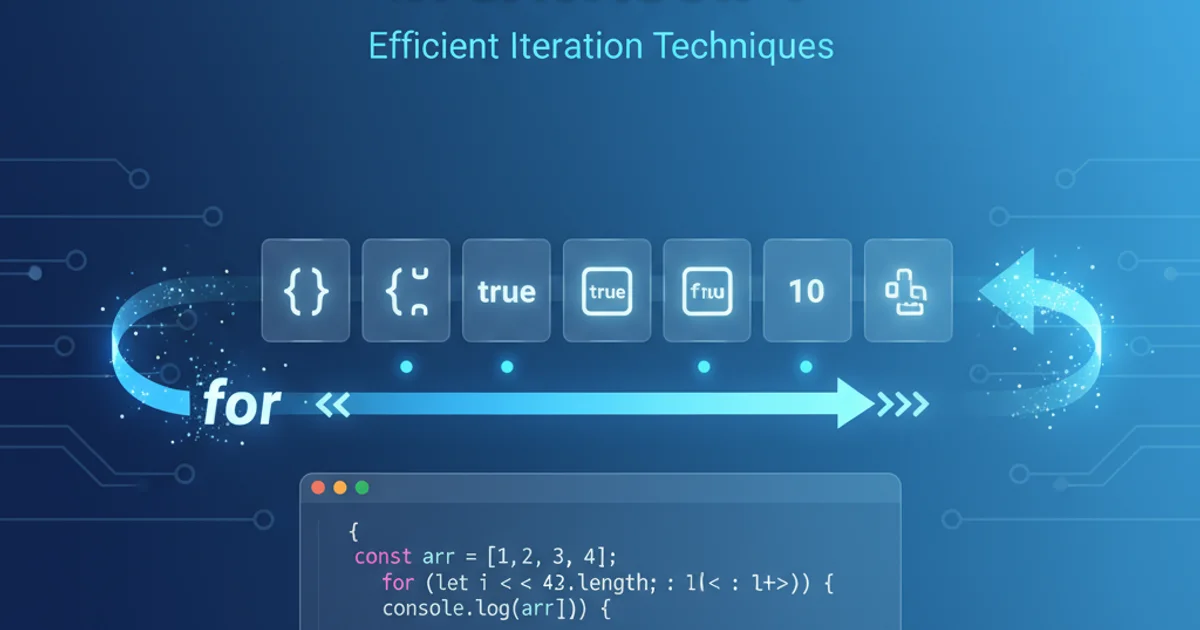Loop through an array in JavaScript
Categories:
Mastering Array Iteration in JavaScript

Explore various methods for looping through arrays in JavaScript, from traditional for loops to modern iteration techniques, with practical examples and performance considerations.
Arrays are fundamental data structures in JavaScript, and iterating over their elements is a common task. Whether you need to perform an action on each item, transform data, or find specific values, JavaScript offers a rich set of looping constructs and array methods to achieve your goals efficiently. This article will guide you through the most popular and effective ways to loop through arrays, highlighting their use cases, advantages, and potential pitfalls.
Traditional Loops: for and for...in
The for loop is the oldest and most basic way to iterate over an array. It provides fine-grained control over the iteration process, allowing you to specify the starting point, the condition for continuation, and the increment step. While powerful, it requires careful management of the index. The for...in loop, on the other hand, is designed for iterating over enumerable properties of an object, and while it can be used with arrays, it's generally discouraged due to potential issues with inherited properties and non-numeric indices.
// Using a traditional for loop
const fruits = ['apple', 'banana', 'cherry'];
for (let i = 0; i < fruits.length; i++) {
console.log(`Fruit at index ${i}: ${fruits[i]}`);
}
// Using for...in (generally discouraged for arrays)
for (const index in fruits) {
console.log(`Fruit at index ${index}: ${fruits[index]}`);
}
Examples of for and for...in loops with an array.
for...in for array iteration. It iterates over enumerable properties, which can include inherited properties or non-numeric keys, leading to unexpected behavior. It also iterates in an arbitrary order, which is often not what you want for arrays.Modern Iteration: for...of and Array Methods
ECMAScript 2015 (ES6) introduced the for...of loop, which provides a more concise and readable way to iterate over iterable objects, including arrays. It directly gives you the value of each element, eliminating the need to manage an index. Beyond loops, JavaScript arrays come with a suite of powerful higher-order functions like forEach(), map(), filter(), and reduce() that offer declarative and functional approaches to array iteration and transformation. These methods are often preferred for their readability and expressiveness.
// Using for...of loop
const colors = ['red', 'green', 'blue'];
for (const color of colors) {
console.log(`Color: ${color}`);
}
// Using forEach()
const numbers = [1, 2, 3, 4, 5];
numbers.forEach(function(number, index) {
console.log(`Number at index ${index}: ${number}`);
});
// Using map() to transform an array
const doubledNumbers = numbers.map(number => number * 2);
console.log('Doubled numbers:', doubledNumbers); // [2, 4, 6, 8, 10]
// Using filter() to select elements
const evenNumbers = numbers.filter(number => number % 2 === 0);
console.log('Even numbers:', evenNumbers); // [2, 4]
// Using reduce() to aggregate values
const sum = numbers.reduce((accumulator, currentValue) => accumulator + currentValue, 0);
console.log('Sum of numbers:', sum); // 15
Examples of for...of, forEach(), map(), filter(), and reduce().
flowchart TD
A[Start Iteration] --> B{Choose Method}
B -->|Need Index & Control| C[Traditional `for` loop]
B -->|Need Value Only| D[`for...of` loop]
B -->|Perform Action on Each| E[`forEach()`]
B -->|Transform to New Array| F[`map()`]
B -->|Filter to New Array| G[`filter()`]
B -->|Aggregate to Single Value| H[`reduce()`]
C --> I[End Iteration]
D --> I
E --> I
F --> I
G --> I
H --> IDecision flow for choosing an array iteration method.
Performance and Best Practices
While modern array methods often offer better readability and maintainability, performance can sometimes be a consideration, especially with very large arrays or in performance-critical applications. Generally, the performance differences between for loops, for...of, and forEach() are negligible for most common use cases. However, for loops can sometimes be marginally faster due to their lower overhead. When choosing a method, prioritize readability and the intent of your code. Use map(), filter(), and reduce() when you need to create new arrays or aggregate values, as they clearly express these operations.
forEach() is often the most readable choice. If you need to break out of the loop early or need more control over the index, a traditional for loop might be more suitable. For creating new arrays based on transformations or filtering, map() and filter() are highly recommended.